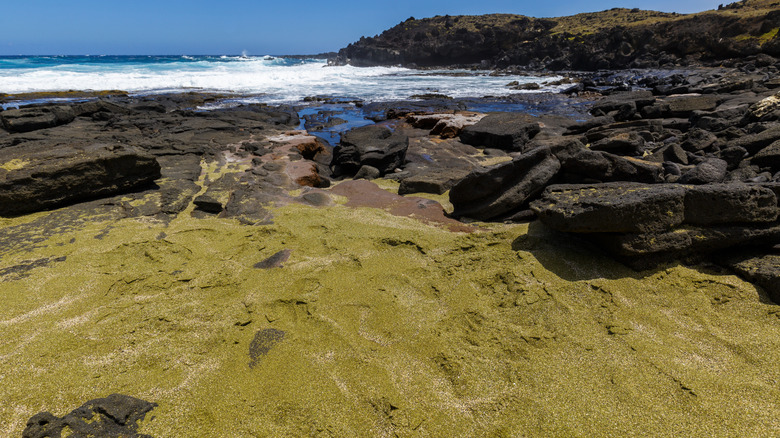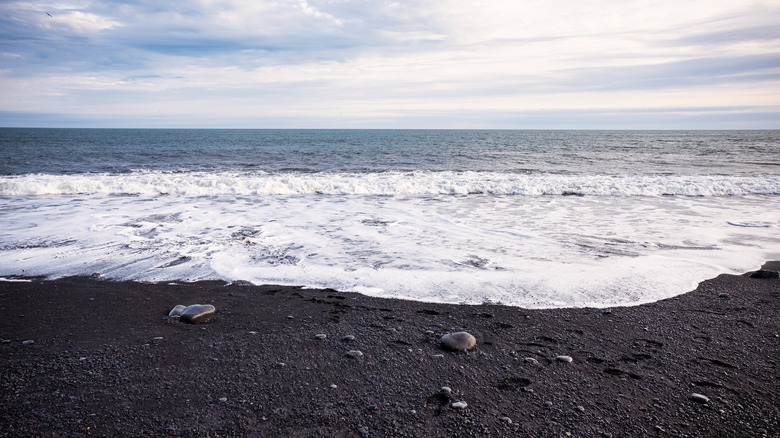Colorful Beaches Around The World With Red, Green, And Pink Sand
Sand is sand, right? Wrong. From black and green to orange and pink hues, coastlines of the world offer an array of colorful sand options. Remember, as you check off your rainbow-beach bucket list, please take only photographs, not sand. While tempting, removing sand from the beach dilutes the color and ruins the experience for future generations.
Visit one of the four green-sand beaches in Hawaii, or travel to Iceland to see remnants of basalt lava pose as sand on one of the most exotic black-sand beaches. No matter your favorite color or what region of the world you travel to, there's sure to be a colorful beach you'll want to check out. Be careful, though: Not all of these beaches on our list are swimmer-friendly.
Read on for a list of our favorite multicolored beaches.
Black Sand: Paioa Beach in Maui, Hawaii
Located in the Waianapanapa State Park, the black "sand" is made mostly from small black rocks. Waianapanapa means "glistening fresh water" in Hawaiian, and it's easy to see where the name came from when the black sand is contrasted against the brilliant blue ocean. The aesthetic easily makes this one of the most beautiful black-sand beaches out here.
Thanks to the scenery, this spot is a must-stop along the Road to Hana. Take as many pictures as you'd like, but save your swimsuit: With the strong surf and frequent jellyfish, opt for a more swimmer-friendly beach.
Orange Sand: San Blas Beach in Gozo, Malta
Located at the bottom of a steep hill on Gozo's northeast coast, San Blas is a small, secluded beach featuring clear water and a marked swimming area. The soft sand — orange due to high iron oxide content — is perfect for lounging the day away in your rented beach chair. A small snack hut and restroom facilities mean you don't have to wander far.
Pink Sand: Pink Beach on Komodo Island, Indonesia
Also known as Pantai Merah, Pink Beach, one of the most famous beaches in the world, is located on Komodo Island, one of more than 17,000 islands in the Republic of Indonesia. One of only seven pink-sand beaches that exist, the color is caused by the red coral mixed with white sand. It's a popular snorkeling spot and suitable for beginners since even the shallows are teeming with marine life. The strand is also located within Komodo National Park, a sanctuary to Komodo Dragons, the world's largest living lizard.
Green Sand: Papakolea Beach on Hawaii Island, Hawaii
Also known as Mahana Beach, you'll find this unique, green-sand beach (one of only four green beaches in the world) on the southern tip of Hawaii's Big Island. Nestled in a bay at the base of the Pu'u Mahana cinder cone, this remote beach requires a windy, five-mile, round-trip hike, or you can hitch a ride from a local for about $15 per person. There are no facilities, and the surf is too strong for swimming. The appeal, however, is the rare green sand, created by olivine crystals, a common silicate deposit of Big Island lava.
Red Sand: Kaihalulu Beach in Maui, Hawaii
Comprised of red and black lava cinders, this red-sand beach in Hana is the perfect spot to snap selfies. Go early to find parking, but you probably shouldn't bring the little ones: The tricky trail to the beach is narrow and steep (plus, the hard-to-find location makes the spot popular among nudists).
Bring sturdy shoes for the hike and a snorkel mask, as the lava rock wall creates a protected cove for prime snorkeling.
Pink Sand: Horseshoe Bay Beach in Bermuda
Where did this beach, named for its curved shape, get its pink flecks? It's from Foraminifera, a red microscopic organism with a reddish-pink shell. They grow profusely on the underside of Bermuda's coral reefs, and their shells mix with the sand. Horseshoe is part of a collection of South Shore beaches and is one of the most popular spots with tourists and locals. Expect all the amenities you could ask for: chairs, umbrellas, snorkeling-gear and boogie-board rentals, bathrooms, and a low-key restaurant.
Black Sand: Reynisfjara Black-Sand Beach in Iceland
Just off Ring Road near the southernmost town of Vik, this black-sand beach gets its color from smooth pebbles and stones that are the remnants of basalt lava. Selfie-worthy sights include Gardar, a cliff made of hexagonal-shaped basalt columns that form a step-like pyramid. It's created as part of columnar jointing, a type of lava-cooling process.
Basalt sea stacks, known as Reynisdrangar, are also worthy of a photo (local legend says there were two Icelandic sea trolls who tried to drag a ship to land, but daylight broke and turned them into these stone formations). Beachgoers beware: This is not a spot for swimming. The currents and waves are strong, and waves can sneak up on you. There have even been a few fatal accidents with unsuspecting people having been swept into the ocean.
Pink Sand: Harbour Island in the Bahamas
This three-mile-long beach, located on the east side of Harbour Island, is the perfect spot for snorkeling and swimming, thanks to the reef that provides a large area of calm and relatively shallow water. The sand is made from bits of coral, shells, rocks, and calcium carbonate from marine invertebrates. Just like Bermuda's Horseshoe Bay, this pink-sand beach, one of the best beaches in the Caribbean, gets its color from Foraminifera.
Red Sand: Cavendish Beach in Prince Edward Island, Canada
Part of Prince Edward Island National Park, this beach features silky red sand and all the necessary amenities — food, parking, restrooms, and lifeguards — for a perfect family beach day. The distinctive red sand gets its color from eroding sandstone cliffs on PEI's north shore. For the active set, there are ample hiking and biking trails nearby.









